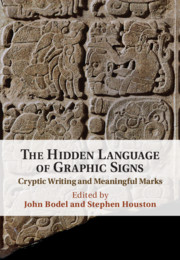Book contents
- The Hidden Language of Graphic Signs
- The Hidden Language of Graphic Signs
- Copyright page
- Contents
- Contributors
- Abbreviations
- Introduction
- Part I Hidden Writing
- Part II Legible Signs
- Seven Marking and Writing in an Egyptian Workmen’s Community
- Eight The Semiotics of Signa and the Significance of Signs in Roman Stamps
- Nine Late Antique and Early Medieval Monograms
- Ten Crests and Familial Identity in Medieval Japan
- Eleven Where Credit’s Due
- Twelve From Modeling to Destruction
- References
- Index
Eight - The Semiotics of Signa and the Significance of Signs in Roman Stamps
from Part II - Legible Signs
Published online by Cambridge University Press: 23 August 2021
- The Hidden Language of Graphic Signs
- The Hidden Language of Graphic Signs
- Copyright page
- Contents
- Contributors
- Abbreviations
- Introduction
- Part I Hidden Writing
- Part II Legible Signs
- Seven Marking and Writing in an Egyptian Workmen’s Community
- Eight The Semiotics of Signa and the Significance of Signs in Roman Stamps
- Nine Late Antique and Early Medieval Monograms
- Ten Crests and Familial Identity in Medieval Japan
- Eleven Where Credit’s Due
- Twelve From Modeling to Destruction
- References
- Index
Summary
The workmen employed in royal tomb construction of the Egyptian New Kingdom (ca. 1539‒1077 BCE) used hieroglyphic, pictorial and abstract graphic signs when marking their property and presence, and for the creation of administrative records on ostraca. In the course of the New Kingdom, this system of identity marks developed into a complex, pseudo-written code. This chapter discusses the hybrid morphology of the marks and the way it came about. It is suggested that the morphology and use of the marks reflect the extent and nature of (semi-)literacy within the workmen’s community.
- Type
- Chapter
- Information
- The Hidden Language of Graphic SignsCryptic Writing and Meaningful Marks, pp. 173 - 198Publisher: Cambridge University PressPrint publication year: 2021
- 1
- Cited by

